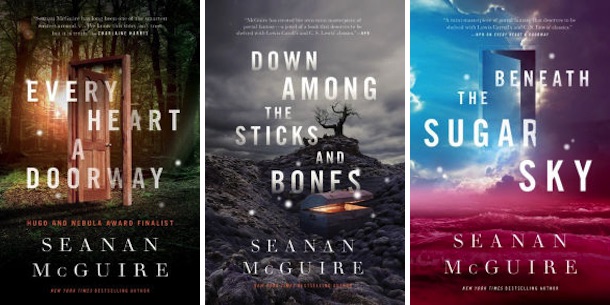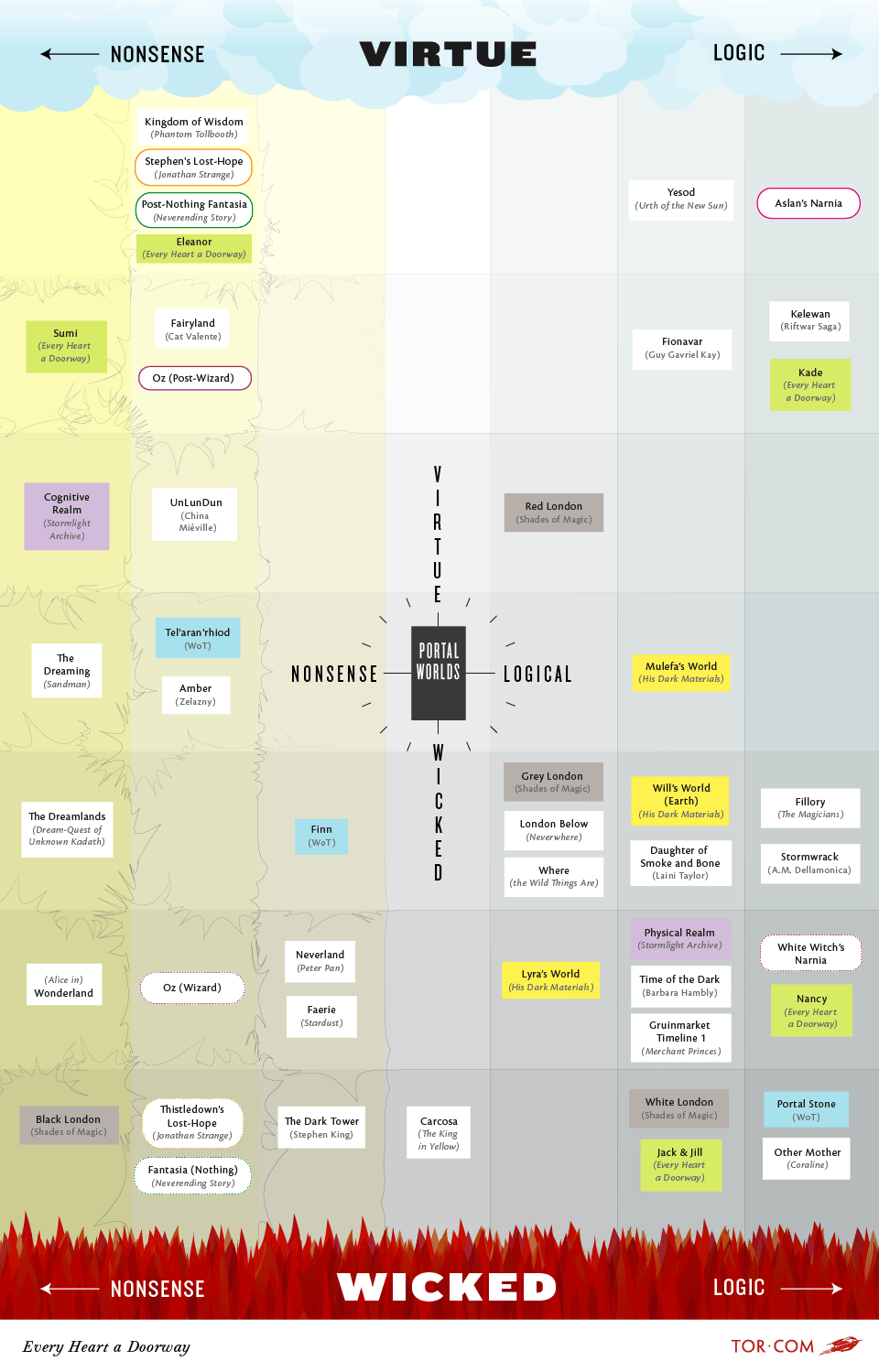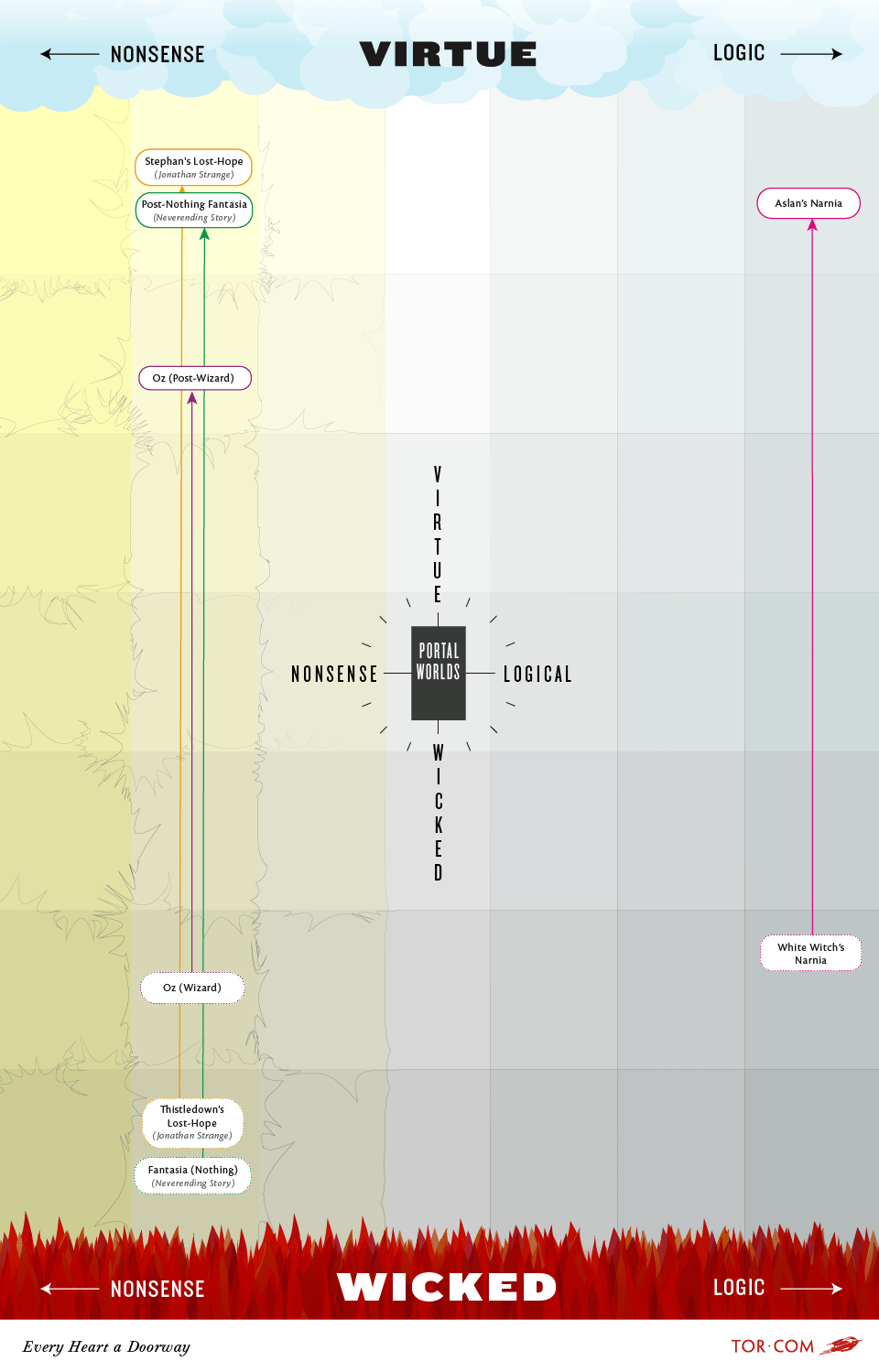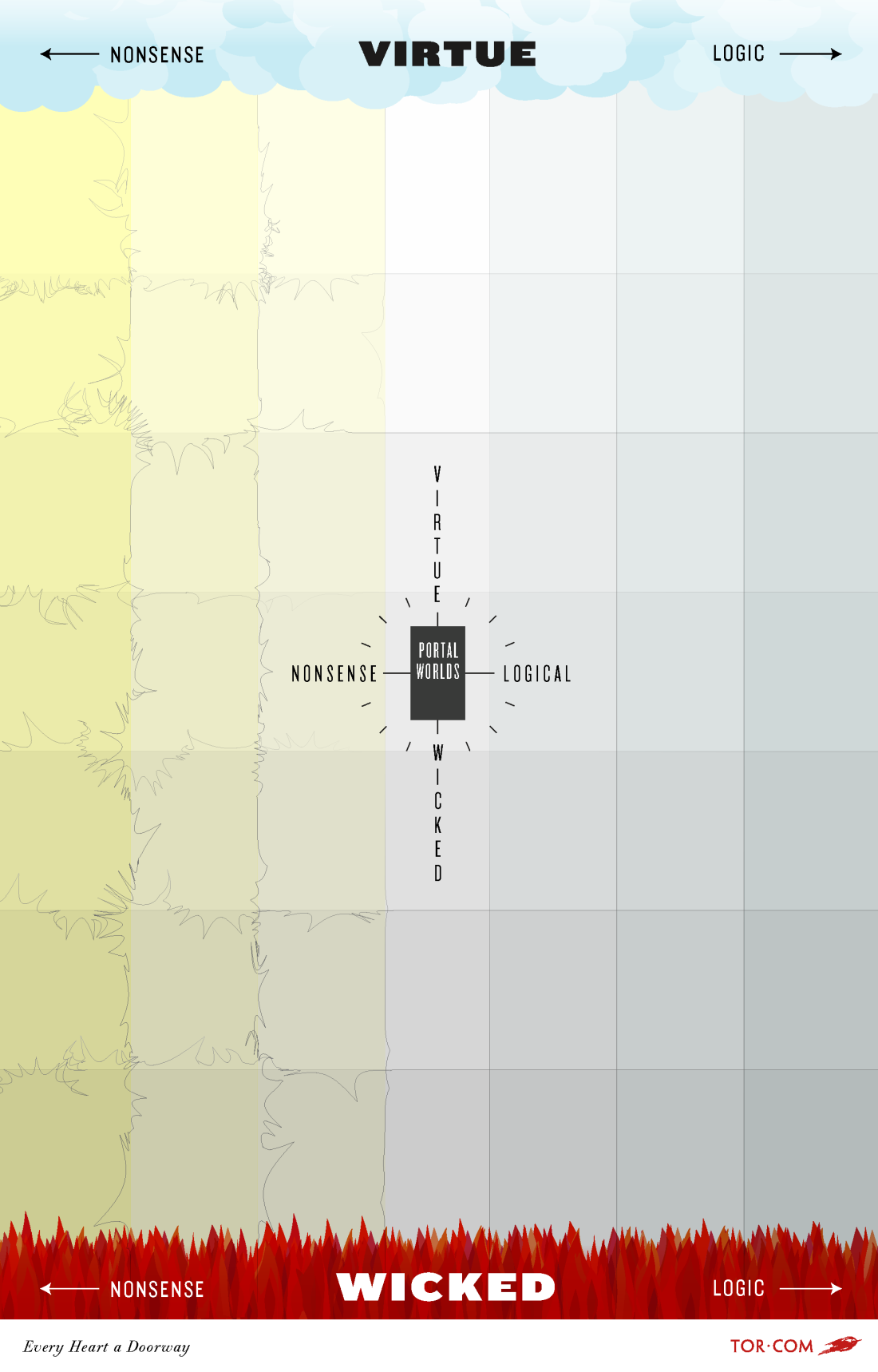Seanan McGuire’s Wayward Children series returns on June 13 this year with Down Among the Sticks and Bones (then again in early 2018 with Book 3, Beneath the Sugar Sky!) expanding on the origin of “portal fantasy” children Jacqueline and Jillian. (Also known as Jack and Jill.)
The Wayward Children series explores how to deal with real life once the portal to your own personal magical world has closed, but it also gives readers a rough guideline for how all of these different portal worlds—like Narnia, Oz, Wonderland, and so on—relate to each other.
Every Heart a Doorway explains:
Here in the so-called “real world” you have north, south, east, and west, right? Those don’t work for the most of the portal worlds we’ve been able to catalog. So we use other words. Nonsense, Logic, Wickedness, and Virtue. There are smaller sub-directions, little branches, but those four are the big ones. Most worlds are either high Nonsense OR high Logic, and then they have some degree of Wickedness or Virtue built into their foundations from there. A surprising number of Nonsense worlds are Virtuous. It’s like they can’t work up the attention span necessary for anything more vicious than a little mild naughtiness.
We saw that and wondered…could we use the series’ guidelines to map ALL of the different portal worlds in fiction into a single multiverse?
It took some doing. “Portal worlds” are only as knowable as their author/creator allows them to be and the aspects of some of them change over the course of the story in which they are featured. In addition, the four main axes—nonsense, logic, wickedness, and virtue—are themselves subjective on a personal and cultural level: One person’s estimation of High Virtue can easily be another person’s estimation of Wickedness.
Thankfully, McGuire’s Wayward Children novellas give us a few different portal worlds that serve as examples of various degrees of the aspects known as nonsense, logic, wickedness, and virtue. With these in hand, we were able to form subjective gradations that could encompass all of the guidelines and examples presented by McGuire, allowing us to place all magical portal worlds into a precise grid (our “multiverse”) while remaining generalized enough to allow those worlds to move around the grid without conflict.

Here’s How The Grid Works:
y axis = Virtue 3, 2, 1, 0, 1, 2, 3 Wickedness
x axis = Nonsense 3, 2, 1, 0, 1, 2, 3 Logic
The below grid has two axes based on the four Aspects noted in Every Heart.
The y axis (up and down) starts in the north with High Virtue. Worlds become less virtuous the further south on the axis you go, until they’re High Wicked. There are three gradations of Virtue and three gradations of Wicked, with a null (zero) state in between them. This means our portal world multiverse is 7 rows tall.
The x axis (right and left) starts in the west with High Nonsense. Worlds become more logical as you head east, until they’re High Logic. There are three gradations of Nonsense and three gradations of Logic with a null (zero) state in between them. This means our portal world multiverse is 7 columns wide.
How Nonsense Is Your Favorite World?
It’s one thing to say that Eleanor’s portal world in Every Heart is “Nonsense 2” but what does that mean? Here’s how we’re defining the three gradations of every Aspect:
- Nonsense 3 = Environment completely pliable and redefinable. Change motivated by personal whim. Near-chaos. Examples include: The Dreaming from Neil Gaiman’s Sandman.
- Nonsense 2 = World on the tipping point between fantastical chaos and realistic environments. Examples include: Oz.
- Nonsense 1 = Reality is pliable through wish fulfillment, but cause and effect actions are still most effective. Examples include: Neverland from the Peter Pan tales.
- Nonsense/Logic 0 = Stasis, no change occurs in world.
- Logic 1 = Most things follow rules of cause-and-effect but there is still doubt as to how many things follow rules. Examples include: Lyra’s world from The Golden Compass.
- Logic 2 = Everything can be explained eventually, but there will always be unique exceptions. Examples include: Our own world!
- Logic 3 = Everything can be explained, no exceptions to rules. Examples include: Narnia, and most any other world where its god/creator has a direct influence.
How Virtuous Is Your Favorite World?
- Virtue 3 = Pure and providential, world provides everything you need. Is in an “ideal” state. Examples include: Narnia once Aslan’s control is restored.
- Virtue 2 = Overriding harmony in world, active championing of human/being rights, but still threatened. Examples include: L. Frank Baum’s Oz, after the Wicked Witch and Wizard are taken out of power.
- Virtue 1 = World provides for its denizens but in a limited capacity, passive promotion of human/being rights. Could be seen as only slightly better than our own world. Examples include: UnLunDun, from China Mieville’s book of the same name.
- Virtue/Wicked 0 = Balance between virtuous and wicked desires, but not harmony. Examples include: The Dreaming from Neil Gaiman’s Sandman.
- Wicked 1 = Unbalanced. Passive or secondary limiting of human/being rights. Examples include: Our own world!
- Wicked 2 = Overriding disharmony. Active limiting of its denizens. “Crapsack World” but livable. Examples include: Narnia when the White Witch is in power.
- Wicked 3 = Actively malevolent, apocalyptic, near-unredeemable, near-unlivable. Examples include: The Dark Tower.
OMG Just Let Me See the Grid Already
Here you go! Design credit goes to Jamie Stafford-Hill.

Hey You Have Narnia On There Twice
That’s because we discovered something really interesting when plotting out this portal world multiverse. Worlds move over time. They slide into Wickedness or correct into Virtue. Check it out:

This means that worlds in a multiverse don’t just have spatial “x, y” coordinates, they have an additional “t” coordinate for the moment in time that you’re measuring them within! Magical worlds float, drift, move…they have vectors, velocity, they insist on being fourth-dimensional! Portal worlds–those magical places we are drawn into–fizz around us like soda pop.
Interestingly, the worlds we chose to depict on the grid only move along the y axis, between Virtue and Wickedness. We couldn’t think of a world that moved along the x axis, which suggests that the Aspects along that axis are more intrinsic to the definition of a world, comprising the core of their reality’s structure.
You’ll also notice that fictional worlds tend to group in certain quadrants and gradations. Worlds don’t really like being in that High Virtue / High Logic space, for example, but that’s probably because we don’t like telling stories about those kinds of worlds. Perfect, happy places where everything is tended to and everything makes sense are a goal, they’re not a story.
Hey You’re Missing…
Oh yes. We stuck to sci-fi/fantasy books mostly, because the multiverse is VAST and full of terrors and we couldn’t make an infographic big enough to contain everything we’ve read. (There are hundreds of portal worlds in comic books alone!)
Really, we can only show you the way.
It is time, perhaps, to chart your own journey through your favorite magical worlds…

(A printable PDF version is available here.)











Interesting. I would have assumed that ‘our world’ would be the zero point, making it the common point of reference for every other, but you haven’t done that here.
The picture helps. When I read Doorway I had a vague, fuzzy image in mind but it wasn’t clear enough for me to really begin thinking about where other portal worlds would fit.
Re: the High Virtue/High Logic dead zone… while you may be right that a world being there doesn’t make for a good story, I rather suspect a helluva good yarn could come out of a world in the process of falling from that lofty height. Or, having done so, fighting its way back to it.
An example of a high wicked and high logic world: Ursula K. Le Guin’s “The Ones Who Walk Away from Omelas”
The Wood Between The Worlds (Narnia) is probably (0,0). It’s a bunch of similar-looking trees, with identical clearings containing identical pools, and each pool contains a world. Nothing really happens there (Polly points out that unless you work very hard at staying alert, you’re likely to just “lie down and drowse forever and ever”). When a world comes into being, so does a pool, identical to all the rest. When a world dies, its pool dries up and immediately becomes covered with the same grass as every place else. It is neither good nor evil; nothing really happens; if you don’t create guideposts for yourself, you will never be able to find your world’s pool again because they’re all exactly alike, and if you’re there long enough, you won’t even care.
I haven’t read Edward Eager’s Knight’s Castle in a bunch of years, but I feel like that’s one that might shift along the x-axis between logic and nonsense. (Kids play with a toy castle then enter into the story they’ve created, from a revision of Ivanhoe to a random baseball game.)
As I said, though, it’s been a long time since I read it.
:O Moar graphs and diagrams! (please)
Could you please explain how you came up with the scores/coordinates? Or are they just ad-hoc based on some other criteria?
The ultimate High Wicked / High Logic (3,3) would be Camazotz from “A Wrinkle In Time”.
If you want to get really technical, The Cognitive Realm and the Physical realm are Cosmere, not just Stormlight Archive, and you’d need to include the third realm- Spiritual, where supposedly things exist in their pure, true form. That would imply Logic 3, but maybe Virtue neutral, because there’s no indication that more things are virtuous or wicked in their pure form.
Just because I’m obsessive like that, here’s a prototype of a webapp that does the mapping:
https://aethercowboy.github.io/torway/
I suggest Piers Anthony’s Xanth as a high logic/high virtue realm. Consider: the realm provides bountifully (lots of food plants, and clothing and bedding literally grow on trees), and good generally triumphs over evil, so it’s definitely high virtue. As for high logic, Xanth operates by a consistent set of rules. Those rules just happen to be based largely on puns. There are also the complex (read: incomprehensible to humans) mathematical formulae that comprise the names of the senior demons (X(A/N)TH, V(E/N}US, E(A/R)TH, etc.).
Neverland’s only Wicked if you go by the original books (which I haven’t read, so feel free to make corrections). Remember, it got picked up by Disney, and they prefer their worlds high Virtue.
For Homestuck, Alternia strikes me as Logic 2/Wicked 2.5. Sburb/the Incipisphere seems like high Logic/null-to-low Virtue, but we don’t see nearly enough of it in the webcomic for me to give precise numbers. The Glitch FAQ/RVAU’s interpretation is also fairly (1.5) Logical, but contrasts with canon in that it’s strongly Wicked at a 2 (though there’s a good chance that, had the canon kids played canon Sburb properly and for long enough, it would have been less Virtuous than the little we see). B1 Earth is identical to our world for most of its lifespan; B2 Earth is Logic 2/Wicked 2; Beforus and Earth C are undefinable for the same reasons as canon!Sburb.
Undertale‘s Underground is Logic 2/Virtue 0.5.
The Barnes and Noble book review roleplays (don’t ask) are Nonsense 3/Virtue 1 to Nonsense 1/Wicked 3 depending on where you go. The main hubs of roleplay, the review sections for the Warriors books, generally average out to null/null in that little actual roleplaying gets done there – it’s mostly advertisements for the review sections where the roleplay actually happens, or where other goings on are occurring. The review section for Scarlet Letter/Oliver Twist/wherever that particular crew is hanging out now is Nonsense 3/null.
For an untitled and unwritten work of mine: Ariadne’s world is Logic 3/Wicked 2, Daniel’s world/Haven is Logic 2/Virtue 0.5, Nikola’s world is Logic 1/Wicked 1, and Sean’s world is Logic 2/Wicked 3.
For In Statu Qui Divinus (original work of mine, unwritten), Orchid’s world is Logic 2/Wicked 1. The Precursors’ world was Nonsense 1/Wicked 1.5 until its destruction. The main world, while otherwise mostly identical to Earth, is downgraded to Logic 1 (except for a select number of people, for whom it acts more like Nonsense 1) because of shenanigans.
The world in “Permutato Orbe Terrarum” (original work) is Nonsense 2/Wicked 1.5.
Nadege’s world (self-indulgent massive crossover fanfiction, unlikely to ever see the light of day) transitioned in the space of under a week from Logic 2/Wicked 1 to Wicked 3, with the Logic/Nonsense coefficient being either Logic 0.5 or Nonsense 3 depending on who you ask (there are rules that are followed, but there are like fifty thousand different and often conflicting sets; wish fulfillment plays a large part, but cause and effect are still a thing, even if they work more off of narrative causality than they used to). That’s what you get when you have every goddamn villain/megalomaniac in the history of fiction converging on one world.
Paradine’s world (untitled original work, unwritten) is Logic 1/Wicked 2.
RZ’s Amber books are already a multiverse, and various characters and peoples can find(or create) new worlds to fit anywhere on the map!
However…
Perfect Logic (4 on the grid) only exists there (as far as I can see) *inside* Dworkin’s ruby. Amber, and other universal poles created using the ruby are highly logical, but, at best, “only” 3.9, and only that in the ‘space’ around that universe’s primal pattern.
Going back in time, before the first pattern was created, it appears that there were just the Courts of Chaos, but even there, from the minimal information we have about them, they aren’t a perfect Nonsense 4. Almost certainly a 3, but perhaps even a high 2.
Thank you for creating an interesting way describe the relationships between universes. Something to consider for a while.
The setting at the end of Heinlein’s ‘The Number of the Beast’ qualify for the Nonsense/Virtue corner of the grid? It seems like it, but it has been a couple of decades since I read the book.
OK, off to think some more.
The internet, rated Nonsense: 3, Wicked: 3.
Fun thread, but I’m baffled by the logic of some of the locations. The physical Cosmere (regardless of planet or time period) comparable to Oz under the Wizard or Narnia under the White Witch, and more wicked than either the Eelfinn or Earth? Huh?
Maybe if you read that as a sort of average score between Scadrial under the Lord Ruler (which might be a Logic/Wicked 3,3 as has been suggested for Camazotz) and other planets/regimes (ranging up to a probable Logic/Virtue 2,2 for Elantris)? Still not seeing how the ‘Finn aren’t significantly further down in Wicked, though. The Aelfinn are arguably amoral, but the Eelfinn are clearly sadistic.